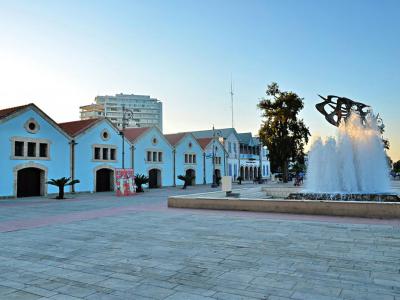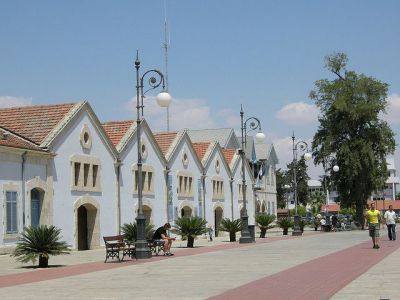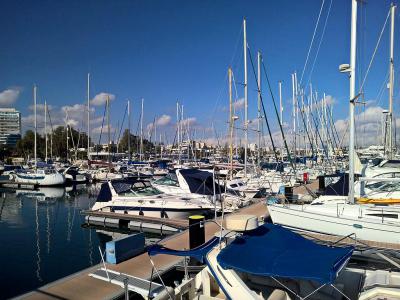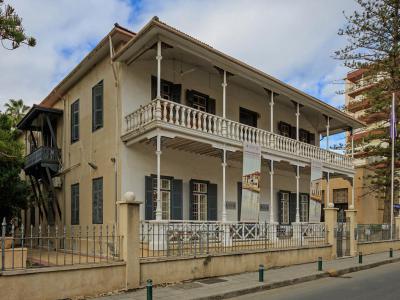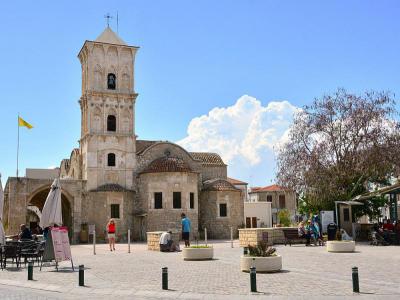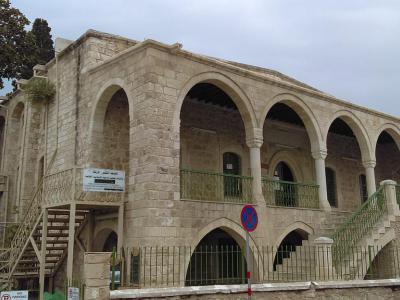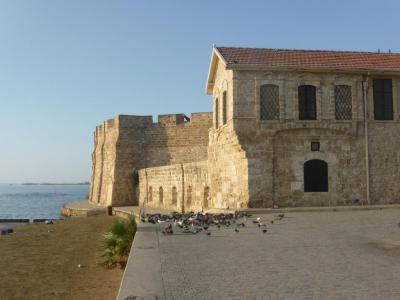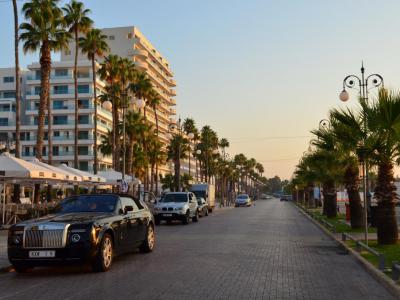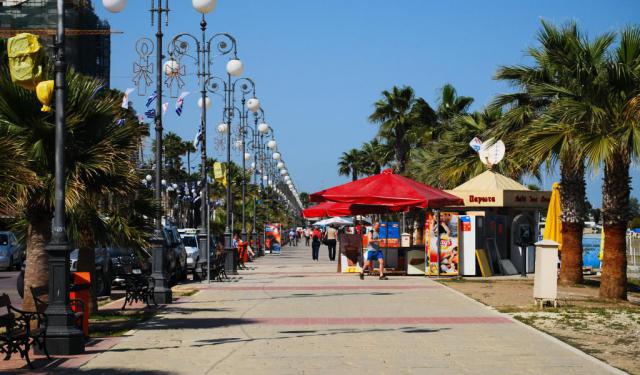Larnaca Introduction Walking Tour (Self Guided), Larnaca
Larnaca is the third-largest city in Cyprus. It was once a city-kingdom known as Kitoin. Though Kition was established in the 13th century BCE, the Phoenicians rebuilt the area around 1000 BCE. Some of the remains from this time, like cyclopean walls and temples, can still be seen today.
The modern name, Larnaca, is derived from the Greek word "larnax" due to the numerous burial sites in the area. A larnax is a small chest used for storing human remains.
Larnaca was a highly prized location due to its rich land and varied resources. Its spot along a trade route was also attractive, and thus its rule was often contested. Over the course of its history, the city was held by the Assyrians, Greeks, Persians, Egyptians, Romans, Ottomans, Byzantines, Venetians, Turks and British.
Today the city is a popular tourist destination due to its beautiful beaches, pleasant weather and many historic landmarks. Finikoudes - The Palm Tree Promenade allows visitors to experience the beach as well as the city as they walk along a palm tree-lined walkway with the sea on one side and shopping, dining and entertainment on the other. It also leads to the Larnaca Marina, which is a great spot for watching the boats or renting one for a pleasant trip on the water.
The city also has a large number of art galleries and museums. Larnaca Fort and the Medieval Museum provides insight into the art, culture and history of the area. The Church of Saint Lazarus and the Armenian Genocide Memorial also provide a glimpse into the history of the city. Europe Square is one of the best known spots in the city with its colonial architecture and numerous public festivals. Europe Square also offers access to the Municipal Art Gallery and Museum of Paleontology.
Take this self-guided walking tour to see all of the most important and interesting places in Larnaca, Cyprus.
The modern name, Larnaca, is derived from the Greek word "larnax" due to the numerous burial sites in the area. A larnax is a small chest used for storing human remains.
Larnaca was a highly prized location due to its rich land and varied resources. Its spot along a trade route was also attractive, and thus its rule was often contested. Over the course of its history, the city was held by the Assyrians, Greeks, Persians, Egyptians, Romans, Ottomans, Byzantines, Venetians, Turks and British.
Today the city is a popular tourist destination due to its beautiful beaches, pleasant weather and many historic landmarks. Finikoudes - The Palm Tree Promenade allows visitors to experience the beach as well as the city as they walk along a palm tree-lined walkway with the sea on one side and shopping, dining and entertainment on the other. It also leads to the Larnaca Marina, which is a great spot for watching the boats or renting one for a pleasant trip on the water.
The city also has a large number of art galleries and museums. Larnaca Fort and the Medieval Museum provides insight into the art, culture and history of the area. The Church of Saint Lazarus and the Armenian Genocide Memorial also provide a glimpse into the history of the city. Europe Square is one of the best known spots in the city with its colonial architecture and numerous public festivals. Europe Square also offers access to the Municipal Art Gallery and Museum of Paleontology.
Take this self-guided walking tour to see all of the most important and interesting places in Larnaca, Cyprus.
How it works: Download the app "GPSmyCity: Walks in 1K+ Cities" from Apple App Store or Google Play Store to your mobile phone or tablet. The app turns your mobile device into a personal tour guide and its built-in GPS navigation functions guide you from one tour stop to next. The app works offline, so no data plan is needed when traveling abroad.
Larnaca Introduction Walking Tour Map
Guide Name: Larnaca Introduction Walking Tour
Guide Location: Cyprus » Larnaca (See other walking tours in Larnaca)
Guide Type: Self-guided Walking Tour (Sightseeing)
# of Attractions: 8
Tour Duration: 1 Hour(s)
Travel Distance: 1.8 Km or 1.1 Miles
Author: AudreyB
Sight(s) Featured in This Guide:
Guide Location: Cyprus » Larnaca (See other walking tours in Larnaca)
Guide Type: Self-guided Walking Tour (Sightseeing)
# of Attractions: 8
Tour Duration: 1 Hour(s)
Travel Distance: 1.8 Km or 1.1 Miles
Author: AudreyB
Sight(s) Featured in This Guide:
- Europe Square
- Municipal Art Gallery and Museum of Paleontology
- Larnaca Marina
- Pierides Museum
- Church of Saint Lazarus
- Buyuk Mosque
- Larnaca Fort and Medieval Museum
- Finikoudes - Palm Trees Promenade
1) Europe Square
Europe Square is a city square near Larnaca Bay. It is notable for being lined with colonial houses built during the 18th century. These former homes now hold popular tourist attractions like the Larnaca Municipal Art Gallery and the Larnaca Historic Archives Museum.
The tranquil square is home to a large fountain called Seagulls in Flight. The sculptured fountain is one of the most iconic sights in Larnaca. Seagulls in Flight was designed by Greek sculptor Theodoros Papayiannis in 1996.
With numerous boat-shaped benches within the square, it is a good place for people watching or taking a break from sightseeing. However, Europe Square can also be very busy at times. It is occasionally used for social, cultural, sporting and music events. One of the most popular is the Village of Santa Claus, which is open from mid-December through early January each year. It is also the starting point for the Larnaca Run road race.
The tranquil square is home to a large fountain called Seagulls in Flight. The sculptured fountain is one of the most iconic sights in Larnaca. Seagulls in Flight was designed by Greek sculptor Theodoros Papayiannis in 1996.
With numerous boat-shaped benches within the square, it is a good place for people watching or taking a break from sightseeing. However, Europe Square can also be very busy at times. It is occasionally used for social, cultural, sporting and music events. One of the most popular is the Village of Santa Claus, which is open from mid-December through early January each year. It is also the starting point for the Larnaca Run road race.
2) Municipal Art Gallery and Museum of Paleontology
The colonial buildings in Europe Square have been around since 1881. Though they were previously used as private residences, the buildings now hold cultural buildings and offices. Some of these are now home to the Municipal Art Gallery and Museum of Paleontology.
Exhibits at the Municipal Art Gallery feature arts from Cyprus and around the world. Permanent collections focus heavily on paintings while temporary, themed exhibits are located in four hallways that are lined with sculptures, paintings, installations and mixed media.
The Museum of Paleontology, located next to the Municipal Art Gallery, opened in 1996. Its collection includes fossils that date as far as 500 million years. The fossils were found in Cyprus and abroad.
The Municipal Art Gallery and Museum of Paleontology is open from Monday through Saturday from 10 AM to 6 PM throughout the year. The museum closes from 1 to 3 PM in the winter months and from 1 to 4 PM during the summer season. It is also closed on public holidays. There is no entrance fee to visit the gallery and museum.
Exhibits at the Municipal Art Gallery feature arts from Cyprus and around the world. Permanent collections focus heavily on paintings while temporary, themed exhibits are located in four hallways that are lined with sculptures, paintings, installations and mixed media.
The Museum of Paleontology, located next to the Municipal Art Gallery, opened in 1996. Its collection includes fossils that date as far as 500 million years. The fossils were found in Cyprus and abroad.
The Municipal Art Gallery and Museum of Paleontology is open from Monday through Saturday from 10 AM to 6 PM throughout the year. The museum closes from 1 to 3 PM in the winter months and from 1 to 4 PM during the summer season. It is also closed on public holidays. There is no entrance fee to visit the gallery and museum.
3) Larnaca Marina (must see)
Larnaca Marina is a marina and mooring facility located in Larnaca Bay. The marina offers mooring for up to 450 vessels. Those who love watching boats come in and out of the bay will enjoy a walk around the marina.
Visitors will find fully paved pedestrian walkways. Pedestrians are welcome to walk to the end of the pier, find a seat and enjoy the relaxing view. They can also visit the nautical themed shop on the premises for a fun souvenir.
Those who want to test the water can book boating trips from the marina. Fishing is also allowed at the end of the pier.
A plan is underway to greatly expand the marina and the surrounding area. Included in the plan is space for more than 200 more vessels, a yacht club, a retail park, residential areas and even a private island. It is expected that this development will more than double the size of the marina and port.
Visitors will find fully paved pedestrian walkways. Pedestrians are welcome to walk to the end of the pier, find a seat and enjoy the relaxing view. They can also visit the nautical themed shop on the premises for a fun souvenir.
Those who want to test the water can book boating trips from the marina. Fishing is also allowed at the end of the pier.
A plan is underway to greatly expand the marina and the surrounding area. Included in the plan is space for more than 200 more vessels, a yacht club, a retail park, residential areas and even a private island. It is expected that this development will more than double the size of the marina and port.
4) Pierides Museum
The Pierides Museum is the oldest private museum in Larnaca. It was founded by the Pierides Foundation who provided the initial collections. The art and artifacts on display were collected over the course of five generations.
The archaeological collection is located in the Pierides family home. The colonial-style building was constructed in 1825 for Demetrios Pierides. It now has exhibits that cover the Neolithic through the Bronze Age. In addition, artifacts from the Archaic, Hellenistic, Roman, Byzantine and Medieval ages are on display in the Pierides home.
There are five halls that have distinctive items in their exhibits. Hall 1 features prehistoric finds from 7000 to 475 BCE. Hall 2 hosts objects from the Archaic to Roman times, from 750 BCE to ADE 395. Hall 3 holds cartography from the mid-15th century through 1960. Halls 4 and 5 display Hellenistic and Roman glass as well as Franconian ceramics.
In 2004, the museum began hosting regular lectures on issues related to exhibitions. The museum is open from 9 AM to 2 PM Monday through Thursday and 9 AM to 1 PM on Friday and Saturday. It is closed on Sunday.
The archaeological collection is located in the Pierides family home. The colonial-style building was constructed in 1825 for Demetrios Pierides. It now has exhibits that cover the Neolithic through the Bronze Age. In addition, artifacts from the Archaic, Hellenistic, Roman, Byzantine and Medieval ages are on display in the Pierides home.
There are five halls that have distinctive items in their exhibits. Hall 1 features prehistoric finds from 7000 to 475 BCE. Hall 2 hosts objects from the Archaic to Roman times, from 750 BCE to ADE 395. Hall 3 holds cartography from the mid-15th century through 1960. Halls 4 and 5 display Hellenistic and Roman glass as well as Franconian ceramics.
In 2004, the museum began hosting regular lectures on issues related to exhibitions. The museum is open from 9 AM to 2 PM Monday through Thursday and 9 AM to 1 PM on Friday and Saturday. It is closed on Sunday.
5) Church of Saint Lazarus (must see)
The Church of Saint Lazarus is an autocephalous Greek Orthodox Church in Larnaca. It was built in the late 9th century. The church is mostly made from limestone block with a thickness of about three feet.
The church was named after New Testament figure Lazarus who according to Eastern Orthodox beliefs, fled to Cyprus after the resurrection of Christ. He was named as the first Bishop of Kition, which would later become Larnaca. The church is rumored to have been built over his tomb.
From the 13th to the 16th century, when Cyprus was under Frankish and Venetian rule, the Church of Saint Lazarus was used as a Roman Catholic church. This was when a Gothic style covered portico was added. The church was used as a mosque during Ottoman rule, at which time the original bell tower and three domes were destroyed. The church was sold back to the Greek Orthodox in 1589.
The current, Latinate-style bell tower on the Church of Saint Lazarus was built in 1857 after the Ottoman rulers allowed their churches to have these towers once more. Further construction was done on the church in the late 20th century after a fire caused significant damage to the interior.
The church contains a five-room museum that holds Byzantine and post-Byzantine icons, vestments, books, sacred utensils, candle holders and wood carvings. Visitors to the Church of Saint Lazarus and its museum are welcome beginning at 8 AM every day except for Sundays. On Sundays, the church opens to the public at 6:30 AM. The church closes at 6:30 PM during the summer season and at 5:30 PM during winter months.
The church was named after New Testament figure Lazarus who according to Eastern Orthodox beliefs, fled to Cyprus after the resurrection of Christ. He was named as the first Bishop of Kition, which would later become Larnaca. The church is rumored to have been built over his tomb.
From the 13th to the 16th century, when Cyprus was under Frankish and Venetian rule, the Church of Saint Lazarus was used as a Roman Catholic church. This was when a Gothic style covered portico was added. The church was used as a mosque during Ottoman rule, at which time the original bell tower and three domes were destroyed. The church was sold back to the Greek Orthodox in 1589.
The current, Latinate-style bell tower on the Church of Saint Lazarus was built in 1857 after the Ottoman rulers allowed their churches to have these towers once more. Further construction was done on the church in the late 20th century after a fire caused significant damage to the interior.
The church contains a five-room museum that holds Byzantine and post-Byzantine icons, vestments, books, sacred utensils, candle holders and wood carvings. Visitors to the Church of Saint Lazarus and its museum are welcome beginning at 8 AM every day except for Sundays. On Sundays, the church opens to the public at 6:30 AM. The church closes at 6:30 PM during the summer season and at 5:30 PM during winter months.
6) Buyuk Mosque
Buyuk Mosque is much more than a tourist attraction in Larnaca. The mosque is a place of pilgrimage for Muslims as it is thought to be the first Ottoman mosque built in Cyprus. Buyuk Mosque is sometimes referred to as the Grand Mosque or the Kebir Mosque.
The mosque was constructed in 1835 by Segit Mehmet Elkhak on the site of a 13th century Catholic church. It is a two-story building with a large minaret and an outdoor courtyard. Marble tombs bearing Islamic inscriptions are located outside. Also outside of the mosque is a drinking fountain that was built in 1748. It was constructed to draw water from Larnaca's aqueduct.
All visitors are welcome at the mosque. However, all visitors must remove their shoes before entering the building. Likewise, women must keep their heads and shoulders covered while inside as a sign of respect.
The mosque was constructed in 1835 by Segit Mehmet Elkhak on the site of a 13th century Catholic church. It is a two-story building with a large minaret and an outdoor courtyard. Marble tombs bearing Islamic inscriptions are located outside. Also outside of the mosque is a drinking fountain that was built in 1748. It was constructed to draw water from Larnaca's aqueduct.
All visitors are welcome at the mosque. However, all visitors must remove their shoes before entering the building. Likewise, women must keep their heads and shoulders covered while inside as a sign of respect.
7) Larnaca Fort and Medieval Museum (must see)
The Larnaca Fort and Medieval Museum is arguably the top tourist attraction in Larnaca. It was built by Lusignan King Iacov I in the 14th century on the grounds of a previously built 11th century fortress. The castle was destroyed, and then rebuilt from the ground up in 1625.
Once the castle was no longer used as fortification it was utilized as a police station and prison while under British rule. This continued through the mid-20th century. It served as the Larnaca District Museum in 1948, and then took its current role as a provincial museum in 1969.
The Medieval Museum is located on the second floor of the fort at the end of the Finikoudes. The three-room collection offers exhibits and artifacts from 4th through the 19th centuries. Among the exhibits, visitors will find Byzantine wall paintings, Medieval glazed pottery, Venetian helmets and swords and Ottoman cooking utensils.
The castle courtyard is now used as an open-air theatre during the summer season. Visitors to the courtyard will also see a collection of artillery that dates to the Middle Ages. A square tower sits on the east side of the castle under which there are tombstones dating from the 15th to the 18th centuries.
Larnaca Fort and Medieval Museum are open throughout the year. Winter hours are 8 AM through 5 PM while summer hours are 8 AM to 7:30 PM. On Saturdays and Sundays during winter and summer seasons the hours are abbreviated to 9:30 AM through 5 PM.
Once the castle was no longer used as fortification it was utilized as a police station and prison while under British rule. This continued through the mid-20th century. It served as the Larnaca District Museum in 1948, and then took its current role as a provincial museum in 1969.
The Medieval Museum is located on the second floor of the fort at the end of the Finikoudes. The three-room collection offers exhibits and artifacts from 4th through the 19th centuries. Among the exhibits, visitors will find Byzantine wall paintings, Medieval glazed pottery, Venetian helmets and swords and Ottoman cooking utensils.
The castle courtyard is now used as an open-air theatre during the summer season. Visitors to the courtyard will also see a collection of artillery that dates to the Middle Ages. A square tower sits on the east side of the castle under which there are tombstones dating from the 15th to the 18th centuries.
Larnaca Fort and Medieval Museum are open throughout the year. Winter hours are 8 AM through 5 PM while summer hours are 8 AM to 7:30 PM. On Saturdays and Sundays during winter and summer seasons the hours are abbreviated to 9:30 AM through 5 PM.
8) Finikoudes - Palm Trees Promenade
The Palm Trees Promenade of Finikoudes is a 600 meter (about 1,968 foot) coastal pedestrian road lined with palm trees. The trees were planted along the length of the road to create a tropical atmosphere. The promenade provides a path to tourist spots, shopping, dining and nightlife.
The beach front of the Palm Trees Promenade is where visitors can find restaurants, bars and a great deal of entertainment. Tourists who wish to stop and enjoy the beach can rent sea beds and umbrellas just off of the promenade. There are several entries to the coastal front from the promenade.
Those who prefer shopping will find plenty of shops and boutiques on the opposite side of the promenade along Athens Avenue. At one end of the promenade is Larnaca Marina and the pier. At the other end is a statue of the lion dedicated to the twin cities of Larnaca and Venice. Beyond this is the Larnaca Fort and Medieval Museum.
The beach front of the Palm Trees Promenade is where visitors can find restaurants, bars and a great deal of entertainment. Tourists who wish to stop and enjoy the beach can rent sea beds and umbrellas just off of the promenade. There are several entries to the coastal front from the promenade.
Those who prefer shopping will find plenty of shops and boutiques on the opposite side of the promenade along Athens Avenue. At one end of the promenade is Larnaca Marina and the pier. At the other end is a statue of the lion dedicated to the twin cities of Larnaca and Venice. Beyond this is the Larnaca Fort and Medieval Museum.
Walking Tours in Larnaca, Cyprus
Create Your Own Walk in Larnaca
Creating your own self-guided walk in Larnaca is easy and fun. Choose the city attractions that you want to see and a walk route map will be created just for you. You can even set your hotel as the start point of the walk.
Seaside Promenade Walk
Throughout its multi-thousand-year history, Larnaca has "moved" several times, not only along the sea, but also inland and back, towards the shore. Today, the promenade of Larnaca is the very heart of the city, stretching for three kilometers.
For most tourists Larnaca is just the place where the Airport is located and the first thing they see upon arrival. During the day, herds of... view more
Tour Duration: 2 Hour(s)
Travel Distance: 3.0 Km or 1.9 Miles
For most tourists Larnaca is just the place where the Airport is located and the first thing they see upon arrival. During the day, herds of... view more
Tour Duration: 2 Hour(s)
Travel Distance: 3.0 Km or 1.9 Miles
The Most Popular Cities
/ view all



